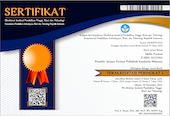HUBUNGAN KANDUNGAN TOTAL POLIFENOL DAN FLAVONOID DENGAN POTENSI ANTIMIKROBA LIMBAH KANGKUNG DAN BAYAM TERHADAP PERTUMBUHAN BAKTERI PENYEBAB INFEKSI NOSOKOMIAL
Abstract
Correlation Between Total Polyphenol And Flavonoid Contents With Antimicrobial Potential Of Kale And Spinach Waste Against Bacterial Growth Causing Nosocomial Infection
Spinach and kale are vegetables that are widely consumed by the public. However, parts of the plant that are not consumed are discarded and end up as household organic waste. Therefore, this research aims to determine the total polyphenol and flavonoid levels, as well as the potential of household organic waste as an antimicrobial cause of nosocomial infections. The household organic waste used in this research were untreated and waste parts of kale and spinach, extracted by the extortion method and then dried using a freeze dryer. Furthermore, the total polyphenol content was determined using the Folin-Ciocalteau method, the total flavonoids with AlCl3 reagent, and the antimicrobial potential using the agar diffusion method. The results showed that the total polyphenol content in kale and spinach waste were 4.67 and 3.91 mg GAE / gram extract respectively. Water spinach and spinach waste do not contain flavonoids, meanwhile, kale and spinach waste have antimicrobial potential against Pseudomonas aeruginous and Staphylococcus aureus. The statistical results showed that there was a relationship between the total polyphenol content and the antimicrobial potential of Kale and spinach waste extracts, the higher the concentration of the extract the greater the inhibition against Pseudomonas aeruginous and Staphylococcus aureus.
Keywords : Total polyphenols, total flavonoids, antimicrobial potential, organic household waste, nosocomial infections.
Bayam dan kangkung merupakan sayuran yang sering dikonsumsi masyarakat namun bagian tanaman yang tidak dikonsumsi dibuang dan berakhir sebagai limbah rumah tangga organik. Tujuan penelitian ini adalah untuk menentukan kandungan total polifenol dan total flavonoid, menentukan potensi limbah rumah tangga organik sebagai antimikroba penyebab infeksi nosocomial serta menentukan hubungan kandungan total polifenol dan kandungan total plavonoid terhadap potensi antimikroba limbah rumah tangga terhadap pertumbuhan bakteri penyebab nosocomial. Limbah rumah tangga organik yang digunakan adalah bagian kangkung dan bayam yang tidak diolah dan dikonsumsi, diekstraksi dengan metode perasan kemudian dikeringkan dengan menggunakan freeze dryer. Selanjutnya dilakukan uji kandungan total polifenol dengan metode Folin-Ciocalteau dan total flavonoid dengan pereaksi AlCl3, penentuan potensi antimikroba dengan metode difusi agar. Hasil yang diperoleh kandungan total polifenol pada limbah kangkung sebesar 4,67 mg GAE/gram ekstrak sedangkan untuk Ekstrak limbah Bayam sebesar 3,91 mg GAE/gram ekstrak. Limbah Kangkung dan Bayam tidak mengandung senyawa flavonoid. Limbah Kangkung dan Bayam memiliki potensi antimikroba terhadap Pseudomonas aeruginosae dan Staphylococcus aureus. Hasil uji statistik menunjukkan Terdapat hubungan antara kandungan total polifenol dengan potensi antimikroba ekstrak limbah Kangkung dan Bayam dimana semakin tinggi konsentrasi ekstrak semakin besar daya hambatnya terhadap Pseudomonas aeruginosae dan Staphylococcus aureus
Kata Kunci : Total polifenol, total flavonoid, potensi antimikroba, limbah rumah tangga organik, infeksi nosokomial.
Full Text:
PDF (Bahasa Indonesia)References
Chun, O.K., Kim, D.O., and Lee, C.Y., 2003, Superoxide Radical Scavenging Activity of The Major Polyphenols in Fresh Plums, J. Agric. Food Chem, 51, 8067-8072.
Hanani, E., 2016, Analisis Fitokimia, Penerbit EGC Medical Publisher, Jakarta
Lay, B.W. 2002 Analisis Mikroba Di Laboratorium. Jakarta: PT. Raja Grafindo Persada
Limbong, E., P., 2017, Uji Aktivitas Antibakteri Ekstrak Etranol Daun Bayam Merah (Athernanthera strigosa Hask) Terhadap Bakteri Staphylococcus aureus dan Escherichia coli. Repisatory Skripsi Universitas Sumatra Utara
Ngajow M., Abidjulu J., Kamu V.S. Pengaruh Antibakteri Ekstrak KUlit Batang Matoa (Pometia pinnata) Terhadap Bakteri Staphylococcus aureus secara In Vitro. Jurnal MIPa,2. 128 - 132
Novita M., M.Iksan Sulaiman, Saufa Yura. 2016. Pengaruh Jenis Pelarut Terhadap Aktivitas Antioksidan dan Kandungan Fenol Beberapa Jenis Bayam dan Sayuran Lain. Jurnal Ilmiah Mahasiswa Pertanian Unsyiah Vol. 1 No. 1, Nov 2016
Tortora Gerard J, et.al, 2001, Microbiology : An Introduction, Edisi 7, Pearson Education. USA, http://www.fk.uwks.ac.id/elib/Arsip/Departemen/Mikrobiologi/inp.pdf. Diakses tanggal 28 Agustus 2019.
Yuliana, A., Albert, 2013, Aktivitas Kangkung Air (Ipomoea aquatic Forssk.) Terhadap Jamur Pityrosporum ovale Hasil Isolasi Secara In Vitro, Jurnal Kesehatan Bakti Tunas Husada.
DOI: https://doi.org/10.32382/mf.v17i1.1960
Refbacks
- There are currently no refbacks.

This work is licensed under a Creative Commons Attribution-NonCommercial-ShareAlike 4.0 International License.
Kontak Editor
Hendra Stevani
Jurusan Farmasi Poltekkes kemenkes Makassar
email : hendra@poltekkes-mks.ac.id

This work is licensed under a Creative Commons Attribution-ShareAlike 4.0 International License.





.png)


